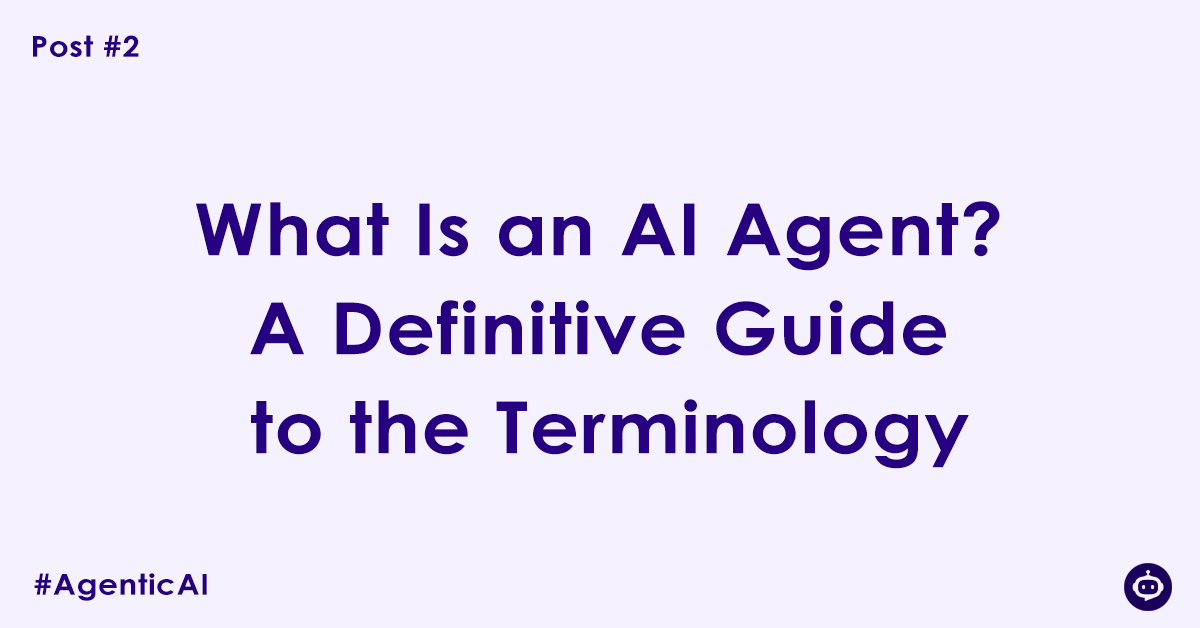In the rapidly evolving world of artificial intelligence, new terms and concepts emerge almost daily. One term gaining significant traction, particularly with the rise of advanced language models, is “AI Agent.” But what exactly constitutes an AI agent? Is it just another fancy word for a program, or does it represent a distinct and powerful paradigm?
To understand Agentic AI (as discussed in our previous post), we first need a clear and precise definition of an “AI Agent” itself.
Defining the AI Agent: A Goal-Oriented Entity
At its core, an AI Agent is an autonomous entity that perceives its environment, makes decisions, and takes actions to achieve specific goals. Unlike a simple program that executes a fixed set of instructions, an agent operates with a degree of independence and intentionality, striving to fulfill its objectives within a dynamic environment.
Think of it this way: a calculator is a program. It performs calculations when you input numbers. An AI agent, however, might be a financial advisor AI that, upon being given the goal “maximize my retirement savings,” would then autonomously research investment opportunities, analyze market trends, execute trades, and adjust its strategy over time.
The Classic PEAS Model: Understanding Agent Components
To fully grasp the structure and function of an AI agent, we often refer to the classic PEAS model, which stands for:
- Performance Measure
- Environment
- Actuators
- Sensors
Let’s break down each component:
- Performance Measure: This defines the criteria for the agent’s success. How do we know if the agent is doing a good job? For our financial advisor AI, the performance measure might be “net growth of retirement portfolio” or “risk-adjusted return.” A self-driving car’s performance measure would include “safety,” “efficiency,” and “adherence to traffic laws.”
- Environment: This is the world in which the agent operates and interacts. It’s everything the agent can perceive and act upon. For the financial AI, the environment includes stock markets, economic news, interest rates, and the user’s financial goals. For a robotic vacuum cleaner, the environment is the physical space of a room, including dirt, furniture, and obstacles.
- Actuators: These are the means by which the agent acts upon its environment. They are the “effectors” that allow the agent to make changes. The financial AI’s actuators might include an API to execute trades, a communication module to send reports, or a system to adjust investment strategies. A robotic vacuum’s actuators are its wheels, brushes, and suction mechanism.
- Sensors: These are how the agent perceives its environment. They gather information and feed it back to the agent’s decision-making process. The financial AI’s sensors would include data feeds from stock exchanges, news aggregators, economic indicators, and user input. A robotic vacuum’s sensors include cameras, ultrasonic detectors, and cliff sensors.
Together, PEAS provides a comprehensive framework for describing any AI agent, regardless of its complexity or domain.
Adapting PEAS for Modern LLM-Based Agents
The advent of powerful Large Language Models (LLMs) like GPT-4 has revolutionized what’s possible with AI agents. While the core PEAS model remains highly relevant, we can adapt it slightly to highlight the unique capabilities and operational mechanisms of LLM-powered agents.
Let’s consider an LLM-based agent designed to write and publish a blog post:
- Performance Measure:
- Traditional: Number of articles published, reader engagement (e.g., clicks, shares).
- LLM Adaptation: Beyond metrics, also includes the coherence, relevance, and quality of the generated content as perceived by human evaluators, reflecting the nuanced output of an LLM.
- Environment:
- Traditional: The internet (for research), a content management system (CMS) interface.
- LLM Adaptation: This expands to include access to vast text corpora for context, external tools (web browsers, APIs for social media, image generators), and the specific constraints and requirements of the target audience and platform (e.g., SEO guidelines, brand voice).
- Actuators:
- Traditional: Writing text, sending commands to a CMS.
- LLM Adaptation: These become the LLM’s ability to generate human-like text (blog posts, headlines, summaries), call external tools (e.g., initiate a web search, request an image from a text-to-image model, post to a social media API), and structure information (e.g., creating outlines, formatting markdown).
- Sensors:
- Traditional: Web scraper for research, feedback from CMS.
- LLM Adaptation: Primarily, the LLM itself acts as a sensor, processing natural language input (prompts, research results), interpreting feedback from external tools, and understanding contextual information. This includes its ability to read and comprehend vast amounts of text from the internet, understand user intent from conversational prompts, and interpret the success/failure messages from API calls.
Why the Distinction Matters
Understanding the components of an AI agent, especially in the context of LLMs, is crucial. It helps us design more effective agents, evaluate their performance accurately, and anticipate their capabilities and limitations. As AI moves beyond simple tools to become sophisticated, goal-oriented partners, a clear grasp of what defines an “agent” will be fundamental to harnessing their full potential. The future isn’t just about powerful models; it’s about intelligent agents powered by those models, acting autonomously to achieve complex objectives.
Author

Experienced Cloud & DevOps Engineer with hands-on experience in AWS, GCP, Terraform, Ansible, ELK, Docker, Git, GitLab, Python, PowerShell, Shell, and theoretical knowledge on Azure, Kubernetes & Jenkins. In my free time, I write blogs on ckdbtech.com
